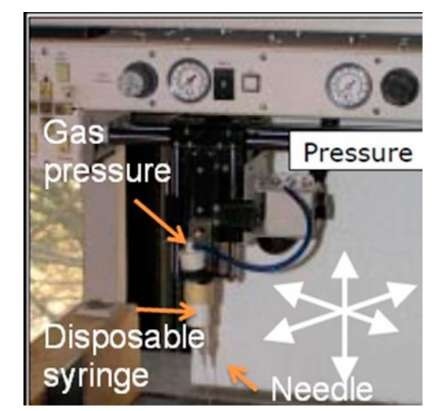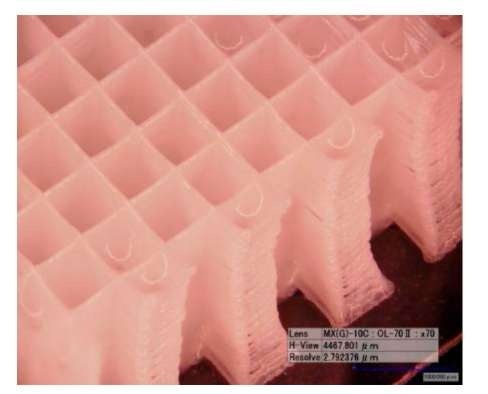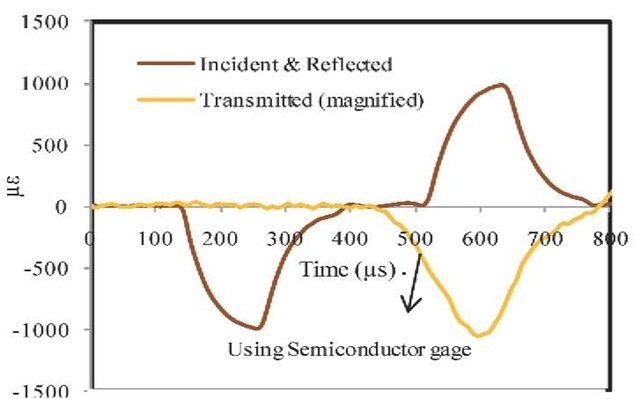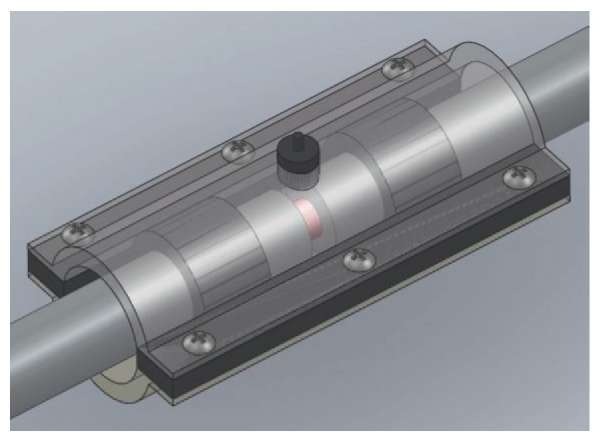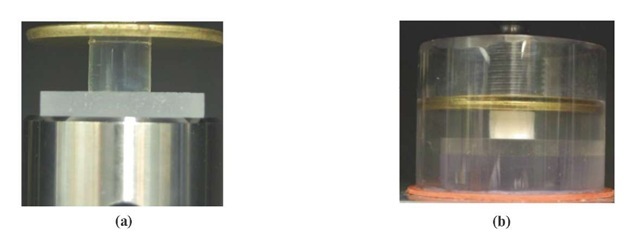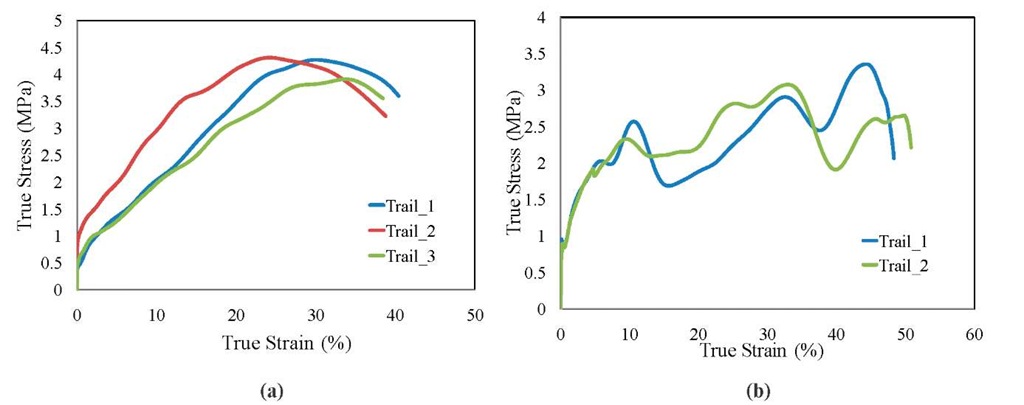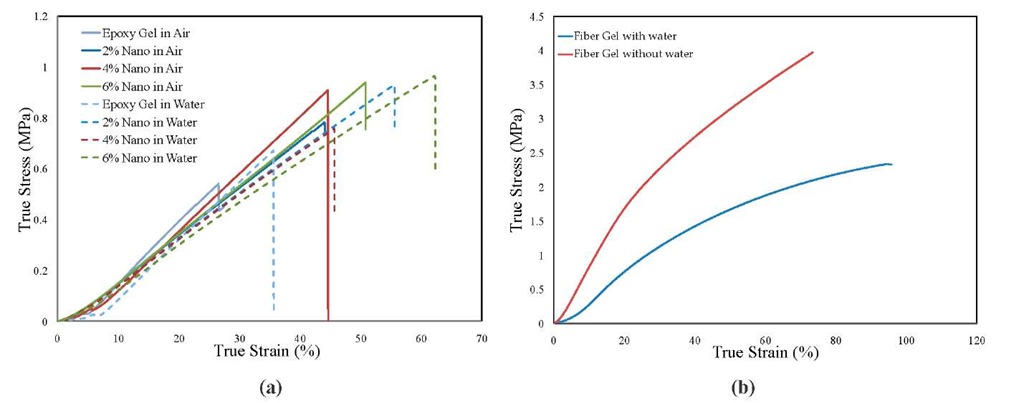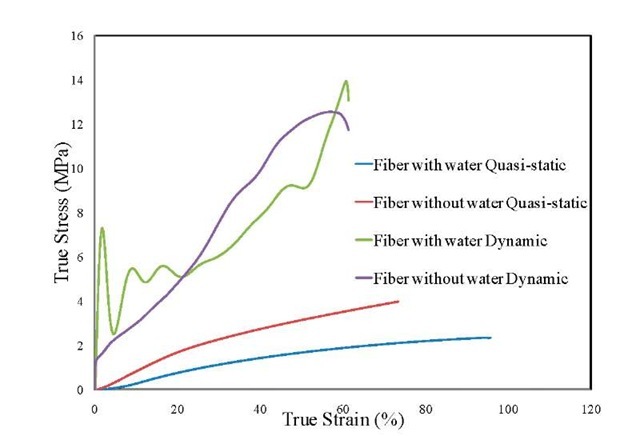ABSTRACT
Quasi-static and dynamic compressive behavior of three different types of hydrogels used for soft tissue applications are tested using a modified split Hopkinson pressure bar. Three kinds of hydrogels: (a) Epoxy hydrogels, (b) Epoxy hydrogels reinforced with definite orientation of three-dimensional polyurethane fibers and (c) fumed silica nano particles reinforced hydrogels with different weight fractions are considered in this study. Swellability of the all the hydrogels considered are studied and controlled by mixing different ratios of jeffamines and epoxides. The three dimensional pattern of the fibers are generated by a rapid robo-casting technique. Split Hopkinson pressure bar (SHPB) was used for dynamic loading and a pulse shaping technique was used to increase the rising time of the incident pulse to obtain dynamic stress equilibrium. A novel liquid environment technique was implemented to observe the dynamic behavior of hydrogels when immersed in water. Experiments were carried out at dynamic loading conditions for different strain rates with and without water environment. Results show that the hydrogels are rate sensitive. Also the yield strength of hydrogels decreased and elongation percent increased when they were immersed in water.
INTRODUCTION
Mimicking human tissues with artificial materials which are bio-compatible and bio-degradable are of vast interest. Hydrogels are extensively used in biomedical applications [1] especially in tissue engineering. They are used as scaffolds to guide the growth of new tissues. Hydrogels are highly corrosion-resistant and their swelling nature provides an aqueous environment comparable to soft tissues. Hydrogels are water swollen polymer networks, which have a tendency of absorbing water when placed in aqueous environment. As the hydrogels tend to swell when fully saturated, these are suitable for biological conditions and are ideal in use of drug delivery. These are hydrophilic polymers that can absorb up to 1000 times their dry weight in water. This high water content makes it a resemblance to living tissues. When hydrogels are completely saturated with water they tend to have poor mechanical properties.
Usage of hydrogels as biological material in different parts of human body is increasing at a rapid pace. With a huge advantage of varying the properties, hydrogels are being used as a replacement for many damaged parts of the body. One example of such a part is human cartilage, which is subjected to high amounts of loads. Recent studies show many researchers have tested and published the mechanical properties of the hydrogels in Quasi-static compression state. Testing soft materials for the dynamic behavior has been a challenging task. Many researchers have worked on soft materials and have achieved success in testing them. Mechanical properties of soft materials like lungs, stomach, heart and liver have been found out at dynamic loading conditions [2]. Dynamic compression tests using polymer split Hopkinson pressure bar (SHPB) apparatus were performed on bovine tissues [3]. PAG gels, an alternative for tissue stimulant has been tested for the dynamic response [4]. Subhash et al., has found the compressive strain rate behavior of ballistic gelatin. All the above testing was performed under open to air environment.
Most of the tissues in human body are surrounded with some type of aqueous environment. This environment change in the body will possess the tissue to behave with different properties. Hence testing the hydrogels in open air environment might vary their properties as compared to aqueous environment. In this paper a novel technique for testing the hydrogels under aqueous environment in both static and dynamic loading conditions were designed, developed and implemented.
Attempts were made to increase the mechanical properties of hydrogels by adding glass fibers and were partially successful [6]. In this study three-dimensional polyurethane fibers and fumed silica nano particles are reinforced into different hydrogels to improve low mechanical properties. A novel liquid environment chamber built with acrylic glass is developed for testing hydrogels in water.
The need of testing materials at high strain rates developed a method which produced mechanical properties of materials at elevated strain rates which in recent time very well known as split Hopkinson pressure bar. This method was widely used for testing materials such as metals as they have high impedance values. However, soft materials like foams and hydrogels have very low impedance values which resist the use of SHPB. The main disadvantage for dynamic testing of soft materials using SHPB arises in capturing the transmitted pulse. Soft materials such as hydrogels have extremely low impedance values, which transmits a very low magnitude pulse into the transmission bar. This makes it very hard to capture the transmitted pulse. In literature, few approaches were adopted to magnify the transmitted pulse, (i) Using a hollow transmission bar Song and Chen, 2004, this technique magnifies the magnitude of the transmitted pulse up to 10 times. However, the magnitude of the pulse in case of hydrogels is so low when compared to incident pulse increasing it 10 times still makes it barely visible, (ii) Using polymeric bars Liu and Subhash, 2006, these bars can provide decent transmitted pulse but it requires lots of assumptions. The wave attenuation and dispersion in the bars requires idealized assumptions about the bar material properties and extensive mathematical treatment of pulses should be obtained in the experiments. To overcome this issue, foil gages were replaced with semiconductor gages on input and output bars. Semiconductor gages have a very high gage factor and these gages have 50-75 times more sensitivity than normal foil gages [4]. This technique is vastly used for characterizing ultra soft and very low impedance materials. Biological materials such as tissues, soft bones and hydrogels are some materials which have been using this technique in recent times. In this paper semiconductor gages are used for data acquisition.
It can be noticed from the above studies that characterization of hydrogels was successfully studied in open to air environment. It was identified from the above studies that there was no detailed study conducted to understand the effect of liquid environment on hydrogels under static and dynamic loading conditions. Hence this paper mainly focused on studying the quasi-static and dynamic constitutive behavior of reinforced hydrogels inside liquid environment.
EXPERIMENTAL DETAILS
Materials and preparation
Three types of hydrogels were considered in this study and are epoxy-amine based. Three kinds of hydrogels are (a) Epoxy hydrogels, (b) Three dimensional Polyurethane fiber reinforced hydrogels and (c) Nano particle reinforced hydrogels. Polyethyleneglycol diglycidylether(PEGDGE) was purchased from Sigma Aldrich. Jeffamine® ED 600 is donated from Huntsman Chemical Company.
Figure 1 Material preparation procedure
Amines were cross linked to epoxides in aqueous solution to form hydrogels. An equal molar ratio of PEGDGE and ED 600 are mixed together with 20-30% weight fraction of H2O. The entire mixture is stirred at a regular pace for 15 min. Thus formed mixture is poured in to acrylic molds and placed in oven at 65-700C for 3 hours. These molds are then cured at room temperature for 24 hours. These samples are placed in de-ionized water for 48 hours to completely swell to get fully saturated epoxy amine hydrogels. Figure 1 shows the pictorial view of the material preparation
Figure 2 Asymtek dispensing system
Figure 3 Three dimensional optical image of PU fiber construct
Figure 2 shows a dispensing system machine were 3D fibers are extruded. This machine is produced from Asymteck. As Figure 2 shows the machine consists of a disposable syringe, a needle and a gas pressure apparatus to pump the solution on to the surface. Required patterns of fibers can be extruded from the machine through a computer program. The machine moves in all the three directions which make it more flexible to generate complex design patterns.10-20% polyurethane solution were prepared in dimethylformamide(DMF). The fibers are extruded through 100^ EFD needle and deposited into 3D structure by pressure driven Asymteck Automove 402 dispensing system as shown in Figure 3. The fiber formation process is based on wet spinning process and deposition technique is similar to robocasting technique. These 3D structures are placed in to hydrogel matrix and the solution is ultrasonicated to form fiber reinforced hydrogel.
Fumed silica nano particles were purchased from Sigma Aldrich. Nano particles are measured for weight and are mixed with epoxy amine hydrogel. This mixture is ultrasonicated in a water bath up to 10 min allowing the particles to disperse. In this paper 2%, 4% and 6% are three different weight fractions of particles used.
Experimental procedure
Figure 4 Split Hopkinson pressure bar
The split Hopkinson pressure bar was used for dynamic testing of hydrogels. Traditionally SHPB consists of an incident bar and a transmission bar and are all made of Aluminum 7075-T651. The striker bar used in these experiments has a diameter of 12.7mm and length 304.79mm. Incident and transmission bars have the diameter of 12.7 mm. Incident bar is 1828.80mm long and transmission bar is up to a length of 1220mm. A Copper C11000 pulse shaper was used in the testing to obtain dynamic stress equilibrium and is placed using KY jelly at the impact end of the incident bar as shown in Figure 4. The specimen is sandwiched between incident bar and transmission bar. Specimen has the thickness of 2.36mm and diameter of 6.35mm. Molybdenum disulfide lubricant is applied between specimen and the contacting surfaces of bars to minimize the friction.
Figure 5 Typical pulses obtained from SHPB
When the striker bar impacts the incident bar, an elastic compressive pulse is generated. This pulse deforms the pulse shaper mounted at the incident bar and creates a ramp in the pulse. This pulse propagates through the incident bar and reaches the specimen bar interface. When it reaches the interface due to impedance mismatch between the bar and specimen some part of the pulse (reflected pulse) is reflected back in to the incident bar and some transmits through the specimen (transmission pulse) to the transmission bar. Strain gages are mounted on both the bars which provide time-resolved measures of the elastic strain in the pulses. For softer materials strain gages were replaced with semi conductor gages as the gage factor of semiconductor gage are very high when compared to foil gages which gives a very high sensitivity to semiconductor gages. Typical pulses obtained from SHPB using semiconductor gages are shown in Figure 5.
Figure 6 Liquid environment specimen fixture
A novel environmental chamber was designed for SHPB at the interface of incident and transmission bar as shown in Figure 6. This fixture ensures that specimen is placed in between bars and an aqueous environment is surrounded around the specimen during the testing time. The fixture is made of acrylic glass has rubber washers fixed in both the bars ensuring no leak of aqueous solution. Sample tests were ran with the liquid environment chamber and ensured that the setup doesn’t restrict the movement of bars.
The specimen undergoes uniform homogenous deformation and the analysis based on one-dimensional wave theory. In order to make the experiment valid when testing soft materials the specimen should be in dynamic equilibrium and should have a near constant strain rate. In this paper, using SHPB we obtained a dynamic stress-strain behavior of hydrogels at a constant strain rate range of 3600-4000/s.
Figure 7 Specimen holders in Quasi-static compression (a) without water (b) with water conditions
The quasi-static compression tests are performed on Instron Materials Testing Machine 5585. Experiments were performed at slow loading rates of 1mm/min. The tests were continued until the specimen is completely crushed at specified loading rate. A setup was also built for testing the hydrogels under water in quasi-static loading conditions. Figure 7 shows the liquid environmental setup built for quasi-static compression experiments
RESULTS AND DISCUSSION
As discussed above a novel environmental chamber was implemented in this study, consistency experiments were ran and the results are showed in Figure 8. Results show that the methods implemented and the material behavior in all tested cases remained same.
Figure 8 Consistency experiments on 2% nano particle hydrogel (a) without water (b) with water conditions
As the hydrogels are soft materials dynamic testing of these materials is a challenging task. The data that we obtain from the tests should be trustable. So, experiments for consistency were performed on all the hydrogels. Currently 2% nano particle hydrogels were randomly considered and presented in this paper.
Figure 9 Comparison of True Stress vs. True Strain curves under quasi-static compression (a) epoxy and nano composite hydrogel (b) fiber reinforced hydrogel
Figure 9(a) shows the comparison of the data obtained from epoxy gels and nano particle gels. Figure 9 clearly indicates the increase of strength of material of pure epoxy gels as the nano particles are added to it. We can also observe that the rate of increase of stress of the material has a significant change when tested in with and without water conditions. When tested in water the material has a low rate of increase and higher elongation percentages. These results conforms that the materials such as hydrogels with a water content of 95% as their volume subjects to a different behavior when tested in different environmental conditions.
Figure 9(b) shows the comparison of fiber reinforced hydrogels in with and without water environment condition. The curves shows that the material behavior is non linear. The compressive stress of the material increased with the increase in strain percent. But the flow stress in this case has a highly nonlinear effect when compared to epoxy and nano particle gels. The non linearity in the material behavior is due to the fibrous structure reinforcement in the hydrogels matrix. The fibers reinforced in the hydrogel when subjected to compression show more stability towards the material allowing it to take higher loads. The material when tested in normal atmospheric conditions has yield strength of 4MPa and has percentage elongation of 70%. Some resistance was observed around the specimen as a result yield strength of the material decreased increasing the percentage elongation of the specimen.
Figure 10 Comparison of True Stress vs. True Strain curves of hydrogels considered under fatigue loading
From the quasi-static experimental data we observed that the data obtained for epoxy gels and nano particle reinforced gels has a linear increase in the stress in both the experimental conditions. And the fiber reinforced hydrogels had a highly non linear increase. So, to confirm the results and to see if there is any hysteresis effect in these specimens fatigue loading experiments was conducted. Fatigue loading was done at a rate of 1 mm/min and up to 10 cycles. The specimens were subjected to an elongation of 20%. Figure 10 shows the results of fatigue loading on all the hydrogels considered in this study. From the figure we can see that there is no significant hysteresis observed in epoxy and nano hydrogels. But the fiber reinforced gels have been subjected to hysteresis confirming the non linear behavior observed in the quasi-static experiments.
Figure 11 Comparison of True Stress vs. True Strain curves under dynamic compression on epoxy and nano composite hydrogel (a) without water (b) with water conditions
Figure 11(a) shows the dynamic true stress- strain curves for a constant strain rate plotted against the quasi-static true stress-strain curves for each hydrogel specimen without water conditions. It can be seen from figures that all the hydrogels are rate sensitive and show significant rate sensitivity. The constitutive response in all the above cases is non linear. The rate of increase of yield stress in case of without water experiments is very high. The yield strength of the material is reached with lesser percentage elongation. It can be observed from the graphs that the flow stress has a significant change when compared to the quasi-static conditions.
Figure 11(b) shows the dynamic true stress- strain curves for a constant strain rate plotted against the quasi-static true stress-strain curves for each hydrogel specimen with water conditions. It can be seen from figure that the materials even when immersed in water are rate sensitive and show significant rate sensitivity. The constitutive response of the materials when immersed in water shows a high non linearity. The pulses when compared to that of regular without water experiments showed a significant change in the strength, elongation and signature of the pulses. The strength of the materials decreased, percentage elongation of the materials increased when tested in water. The reason for this effect in the material as mentioned in the above sections, a plasticizing effect is observed by the material when they are immersed in water and tested. The rate of increase of yield stress in case of with water experiments is less when compared to without water. As mentioned the water experiments produce plasticizing effect, as a result the material experiences high percent elongations. Even in the case of water experiments it can be observed from the graphs that the flow stress has a significant change when compared to the quasi-static conditions.
Figure 12 shows the true stress vs. true strain curve for fiber reinforced hydrogel for both the experimental conditions. Fib er reinforced hydrogels also experiences same behavior as that of the other gels. They are rate sensitive and have the highest yield strength of all the hydrogels tested. Fiber reinforced hydrogel have the highest dynamic yield strength of 12MPa followed with 6% nano particle hydrogels with 6MPa and epoxy gel with 4MPa in without water conditions.
Figure 12 Comparison of True Stress vs. True Strain curves of fiber hydrogel under dynamic compression
CONCLUSIONS
In this paper, a detailed experimental study was conducted to investigate the effect of water environment on three different hydrogel. The change in their material properties was showed significantly. Following are the major outcomes of this study:
Quasi-static characterization
• A linear true stress vs. true strain response was observed with a large deformation in both epoxy hydrogels and nano particle reinforced hydrogels.
• A non linear true stress vs. true strain response was observed for fiber reinforced hydrogels. These hydrogels also possess large percentage elongations.
• Fatigue loading experiments showed no hysteresis in both epoxy hydrogel and nano particle reinforced hydrogel. This also confirms the hydrogel under low loading rates possess linearity.
• In case of PU fiber reinforced hydrogels, fatigue loading on the specimens showed a significant change in the hysteresis. This confirms the fiber hydrogels even under low loading rates show non linearity.
• In water the material is experiencing softening effects which increase the percentage elongation at break.
Dynamic characterization
• Epoxy hydrogel showed significant rate sensitivity at different strain rates. Considerable difference in yield stress from quasi-static conditions to dynamic conditions was observed and the difference ranges between 0.5MPa and 3.5MPa.
• In water epoxy hydrogel showed almost similar characteristics as that of the regular experiment. The yield stress of the material is decreased by increasing the percentage elongation. Considerable difference in yield stress from quasi-static conditions to dynamic conditions was observed and the difference ranges between 0.5MPa and 2.0MPa.
• Nano particle reinforced hydrogels also showed a significant change in their properties when tested under water by reducing the yield stress. Considerable difference in yield stress from quasi-static conditions to dynamic conditions was observed and the difference ranges between 0.5MPa – 0.7MPa and 4.0MPa – 5.5MPa. Under water the yield stress values show 0.5MPa – 0.7MPa and 1.5MPa – 3.0MPa.
• Fiber reinforced hydrogels also show a decrease in yield stress and increase in elongation when tested under water environment.
• In conclusion the rate of increase of flow stress is less in water environment and constitutive response is non linear in all the hydrogels considered.

